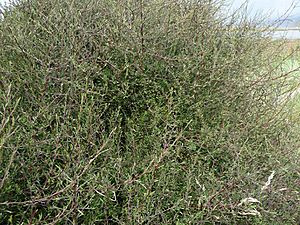Stigmella aigialeia facts for kids
Quick facts for kids Stigmella aigialeia |
|
|---|---|
| Scientific classification | |
| Kingdom: | |
| Phylum: | |
| Class: | |
| Order: | |
| Family: |
Nepticulidae
|
| Genus: |
Stigmella
|
| Species: |
S. aigialeia
|
| Binomial name | |
| Stigmella aigialeia Donner & Wilkinson, 1989
|
|
The Stigmella aigialeia is a tiny moth that belongs to the Nepticulidae family. This special moth is found only in New Zealand, meaning it is endemic to that country.
Contents
Discovering the Stigmella aigialeia
Scientists first described this moth in 1989. Two researchers, Hans Donner and Christopher Wilkinson, studied specimens collected from different places in New Zealand. These places included Auckland, Queen Charlotte Sound, and Invercargill.
The main specimen, called the holotype, was found at Huia Reserve by B. M. May. This important specimen is now kept safe in the New Zealand Arthropod Collection.
What the Moth Looks Like
The young moths, called larvae, are pale yellow. They are very small, only about 3 millimeters long.
When the moth grows into an adult, its wingspan is around 4 millimeters. That's about the size of a grain of rice! The adult moth is mostly grey. Its front wings are brownish-grey and then turn whitish. These front wings also have two small black spots. The back wings are grey. This moth looks a bit like another moth called S. hoheriae, but S. aigialeia is much smaller.
Where This Moth Lives
The S. aigialeia moth is found only in New Zealand. You can find it in both the North Island and the South Island.
Life Cycle and Habits
The larvae of this moth are "leaf miners". This means they live inside the leaves of their host plants. They dig a small tunnel, or "mine," inside the leaf. This tunnel slowly fills up the space between the leaf's top and bottom layers.
Scientists have seen these larvae in April, May, and September. When they are ready to change into adult moths, they make cocoons. These cocoons are made of brown silk and are found on the ground in leaf litter.
Adult moths have been seen flying in January, February, September, and October. They probably have one generation (a full life cycle) each year, but it's possible they have two.
Home and Food
The larvae of the S. aigialeia moth eat the leaves of a plant called Plagianthus divaricatus. Because of this, you can find these moths in coastal areas. These are places like salt marshes and sandbanks, which are where the Plagianthus divaricatus shrub likes to grow.


